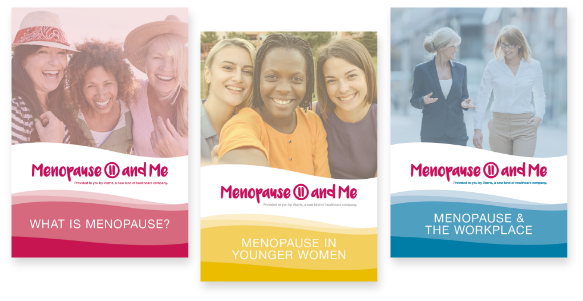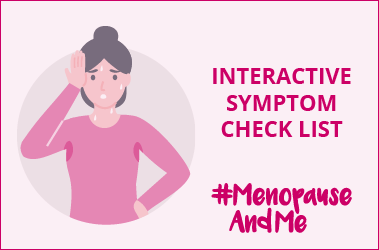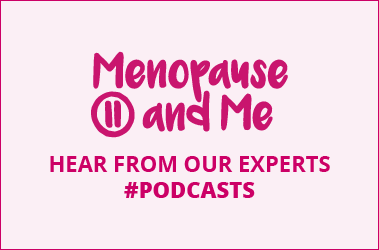
HRT explained
Hormone Replacement therapy (HRT) is a commonly prescribed treatment for menopausal symptoms. As the name suggests, it replaces the hormones that are lost during the menopause.
Not every woman is suitable for HRT. Your healthcare professional will make an assessment of your symptoms and counsel you on what the best treatment is for you.
HRT is available in different types, formulations and can be taken via different routes.
There are three main routes - your doctor or healthcare professional will discuss with you, which route is the most appropriate for you.

Orally via the mouth as a tablet

Transdermal (through the skin) methods. They can take the form of an adhesive patch, gel or spray

For vaginal and bladder symptoms, oestrogen can be taken as a small vaginal tablet, pessary, cream or vaginal ring inserted within the vagina
WHAT DOES HRT DO?
HRT helps to relieve the symptoms caused by oestrogen deficiency in women — such as hot flushes, night sweats, vaginal dryness and osteoporosis and other menopausal symptoms.
WHAT’S RIGHT FOR ME?
Every woman is an individual and the HRT that will best suit you will depend on your individual circumstances, including your stage in the menopausal process, and whether or not you’ve had a hysterectomy. There are many types of different HRT treatments; it is essential that you understand both the short and long-term benefits and risks of each to ensure that you maintain the best possible health and quality of life at every stage of the menopause.
Your healthcare professional will discuss the HRT options with you and you both should make a decision based on your individual needs.
Remember, not every woman is suitable for HRT. Your healthcare professional will assess you and counsel you on what the best treatment option is for you, that is individualised to your needs.
WHAT’S IN HRT?
Most HRT contains two hormones – an oestrogen and progestogen. The oestrogen helps relieve the symptoms of the menopause, whereas the progestogen is there to protect the lining of your womb (uterus).
OESTROGEN ALONE
The core ingredient of all forms of HRT is oestrogen. Oestrogen relieves symptoms such as hot flushes, prevents vaginal symptoms and some strengths of oestrogen can help to maintain bone health.
Women who have had their womb removed may be able to take oestrogen only HRT. Your healthcare professional will decide which treatment is best for you.
Oestrogen only HRT comes in different strengths and different formulations. It is available as a tablet, patch, spray or gel.
OESTROGEN & PROGESTOGEN
If you have a womb your healthcare professional will normally offer you HRT that contains both oestrogen and progestogen. The oestrogen helps relieve the symptoms of the menopause, whereas the progestogen is there to protect the lining of your womb (uterus).
Oestrogen plus progestogen is known as ‘combined HRT’.
In women who have had a partial hysterectomy (with their cervix intact), some womb lining (endometrium) may still remain, so progestogen may be required in combination with oestrogen. Talk to your healthcare professional about which HRT would be most suitable for your individual needs.
Remember, not every woman is suitable for HRT. Your healthcare professional will assess you and counsel you on what the best treatment option is for you, that is individualised to your needs.
TO BLEED OR NOT TO BLEED
The way in which progestogen is taken along with the oestrogen determines whether or not the HRT will lead to bleeding. Adding progestogen for 10 to 14 days a month, means that a bleed occurs in the days following this course, similar to that of a natural menstrual cycle.
If continuous progestogen is given, in combination with oestrogen for 28 days of the month it means that most women will not have a bleed when taking this type of HRT.
Your healthcare professional will advise on which type of HRT is best suited to you, this decision depends on where you are on your menopause journey and your personal health characteristics.
SIDE EFFECTS AND RISKS OF TAKING HRT
As with any drug, there are known side effects from HRT, especially in the first few months of use.
These may include breast tenderness, leg cramps, nausea, bloatedness, irritability and depression.
Talk to your healthcare professional if you have any concerns over side effects. A GP will usually recommend trying HRT for 3 months to see if it helps to relieve symptoms. If treatment is not helping, the GP may recommend adjusting the dose or changing the type of HRT.
Some types of HRT can make you more likely to develop a clot in a vein, which may then travel to the lungs (a condition called venous thromboembolism). It can also increase the risk of stroke and breast cancer.
However it is important to be aware that many factors will influence each woman’s risk of developing these conditions. Her general background health, the type of HRT, and the length of treatment duration will all affect her individual risk.
Your doctor will discuss the risks of HRT and decide with you the most appropriate type of HRT to take.
Reporting of side effects
If you get any side effects, talk to your doctor, pharmacist or nurse. This includes any possible side effects not listed in the package leaflet. Please report side effects with any medicine or vaccine to the medicines regulator MHRA through the Yellow Card Scheme.
It is easiest and quickest to report side effects online via the Yellow Card website: https://yellowcard.mhra.gov.uk/ or search for MHRA Yellow Card in the Google Play or Apple App Store. Alternatively, prepaid Yellow Cards for reporting are available by writing to FREEPOST YELLOW CARD (no other address details necessary), by emailing yellowcard@mhra.gov.uk, by telephoning the Commission on Human Medicines (CHM) free phone line: 0800-731-6789, or by downloading and printing a form from the Yellow Card section of the MHRA website.

EMPOWERING YOUR INFORMED CHOICE OF TREATMENT
The decision to take HRT is an individual one. It depends on how your symptoms are affecting your life, whether you are suitable to take HRT and the balance between the benefits and risks of using HRT.
If you are suitable for HRT and if your healthcare professional advises that it is a good treatment for you, then they will help you to understand the different HRT options available to you, to help you make an informed choice.

Want to know more about the menopause?
Request a free copy of our guidebooks
WHAT IS MENOPAUSE?
MENOPAUSE IN YOUNGER WOMEN
MENOPAUSE & THE WORKPLACE
Request hereRecommended for you
Job Code: NON-2022-0122
Date of preparation: February 2022








